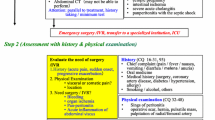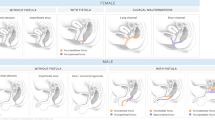Abstract
Foreign body ingestions are common and the vast majority pass through the gastrointestinal tract without complication. Some ingestions, however, result in serious morbidity and mortality. We present a case in which the patient’s chief complaint of severe posterior neck pain was unrelated to his foreign body ingestion (multiple magnets). The ingestion of magnets was not disclosed by the child to either the providing medical team or to the patient’s family. In order to evaluate the patient’s complaint of severe focal neck pain, MRI of the neck was performed. The authors believe it to be feasible that the MRI scan resulted in intestinal perforations that might not have occurred during the natural course of the ingestion. This complication might have been prevented if the patient had undergone screening with a ferromagnetic detector prior to entering the MRI suite. Because of the serious complications related to this case, all pediatric patients at our institution are now screened with ferromagnetic detectors prior to entering the MRI suite. We encourage nationwide policy revision to prevent further incidents similar to the one described in this case.



Similar content being viewed by others
References
Barzin A, Dutta S (2008) Multiple magnet ingestion as a source of severe gastrointestinal complications requiring surgical intervention. Arch Pediatr Adolesc Med 162(2):123–125
Shawis R, Cauchi J (2002) Multiple magnet ingestion and gastrointestinal morbidity. Arch Dis Child 87:539–540
Kim H, Beck N, Lee S (1996) Mischievous: unexpected health hazard in children. J Pediatr Surg 31:1694–1695
Shawis R, Yassa J, Brennan P et al (2002) Children and mini-magnets: an almost fatal attraction. Emerg Med J 19:71–73
Centers for Disease Control and Prevention (CDC) (2006) Gastrointestinal injuries from magnet ingestion in children – United States, 2003-2006. MMWR Morb Mortal Wkly Rep 55:1296–1300
Thomas S, Kanal E (2005) Ferromagnetic detector to screen patients for metallic foreign bodies prior to MR imaging. Abstract presented at the American Society of Neuroradiology annual meeting in Toronto, May 2005
Sass N, Lucey L, Wilcox P et al (2007) ACR guidance document for safe MR practices: 2007. AJR 188:1447–1474
The Joint Commission (2008) Sentinel Event Alert, Issue 38: Preventing accidents and injury in the MRI suite. http://www.jointcommission.org/sentinel_event_alert_issue_38_preventing_accidents_and_injuries_in_the_mri_suite/. Accessed 31 May 2012
Conflicts of interest
We have no conflicts of interest or financial disclosures to declare.
Author information
Authors and Affiliations
Corresponding author
Rights and permissions
About this article
Cite this article
Baines, H., Saenz, N.C., Dory, C. et al. Magnet-associated intestinal perforation results in a new institutional policy of ferromagnetic screening prior to MRI. Pediatr Radiol 42, 1506–1509 (2012). https://doi.org/10.1007/s00247-012-2441-z
Received:
Revised:
Accepted:
Published:
Issue Date:
DOI: https://doi.org/10.1007/s00247-012-2441-z




